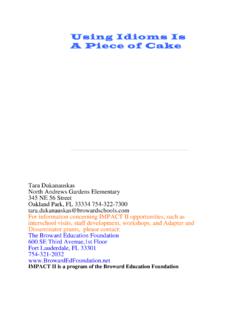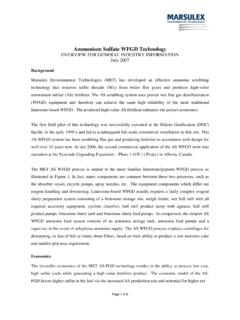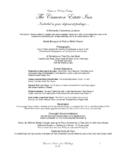Transcription of HAVING YOUR CAKE AND EATING IT TOO: ARE THERE LIMITS …
1 1/The authors are attorneys and a legal assistant in the Washington office of Dewey Ballantine. While the authorshave represented, inter alia, Country Music Television in its recent dispute with Canada, the views are theauthors' own and not those of Dewey Ballantine or its clients. Mr. Ragosta addressed these issues at an April1995 program sponsored by the Trade Committee of the American Bar Association's Section of InternationalLaw and Laureate Robert Lucas, Jr. has aptly described the limitations of economics in setting normative goalsand policies: "As an advice-giving profession, we are way over our heads." Quoted in Washington Post, , 1995. Careful economists like Lucas properly refer to maximizing "utility" -- the total financial and non-financial benefit after all costs -- which may differ from maximizing YOUR CAKE AND EATING IT TOO: ARE THERE LIMITS ON CULTURAL PROTECTIONISM?
2 By John A. Ragosta, John R. Magnus and Kimberly L. Shaw1/published inThe Canadian Law Newsletter, Volume XXX, Summer 1996(A Publication of the Committee on Canadian LawSection of International Law and PracticeAmerican Bar Association)Several major trading partners, most notably Canada and France, have made it atrade policy priority to protect local firms operating in the "cultural" industries -- unfortunately atthe expense of providers of, primarily, audio-visual goods and services. This paper willbriefly discuss cultural protectionism as a trade policy goal and assess the legal framework thatapplies to cultural protection measures between Canada and the United States. Secondly, thepaper will review some of the recent disputes involving cultural Question of BalanceIn one sense, cultural trade protectionists have a valid point. The main criticism one hearsis that protecting domestic suppliers -- whether of information, entertainment, or any othercommodity -- is inefficient, non-wealth-maximizing.
3 Yet, trade policy is not, and never has been,exclusively concerned with overall efficiency. Indeed, it is hard to imagine another area of the lawwould where anyone would be so bold as to suggest that economic values are the only ones with trade policy generally, cultural trade measures present a question of balance. Areasonable balance may well include safeguarding the national culture and supporting the activitiesof those creative individuals who advance it. Yet, that is not to say that countries with culturaltrade measures in effect today have struck a fair balance. On the contrary, in many instances the- 2 -legitimate governmental interest in protecting culture is used as a pretext for crassly protectionistmeasures with primarily economic, rather than cultural, motives and legitimate trade policy goals that must coexist with safeguarding culture include,inter alia: !
4 Consumer/business choice: Particularly in the information and entertainment sectors,consumers should have the most extensive choice of materials possible. This is not only amatter of personal liberty and self expression but -- given the fast-growing global informa-tion highway -- competitiveness. !Projecting culture: Broadly, governments have two options in seeking to promote thenational culture: (1) protecting local suppliers through import barriers and subsidies; or(2) making maximum efforts to project the national culture abroad. The former, whichfocuses on domestic restrictions, can impair a country's ability to project its culture abroad-- especially where met with a reciprocal trade approach. !Sustaining the consensus for trade liberalization: Some governments see cultural pro-tectionism as necessary to sustain domestic support for multilateral or regional liberaliza-tion.
5 On the other hand, exempting this whole sector from trade accords leaves largesegments of the participating economies with no stake in liberalization and, thus, vulner-able to anti-trade messages. !Wealth maximization: As discussed above, this is a very important goal at both thenational and global must constantly monitor the balance among these goals -- but they do notalways do so in a fair or rational way. In theory, THERE are reasons to doubt whether a govern-ment would impose protection other than where truly necessary for preservation of core culturalinterests. In practice, as discussed below, they do so all the time. Hence the need for a systemthat regulates excessive invocation of "culture" to cloak economic promote a proper balance among policy goals, agreements should encourage govern-ments contemplating protective measures to: 1) take care that the action contemplated is, in fact,necessary to encourage significant cultural interests; and 2) avoid to the extent possible beingcaptured by parochial, rather than national cultural, interests.
6 Does such a system exist? Thesystem originally devised by Canada and the United States in 1988 comes close, but its efficacyremains in do the CFTA and NAFTA Address These Issues?The negotiated language on culture is convoluted. Article 2005 of the FreeTrade Agreement (CFTA) states:3/See Jonas M. Grant, "Jurassic" Trade Dispute: the Exclusion of the Audiovisual Sector from the GATT, 70 Ind. 1333, 1334 (1995) (footnote omitted):Trade in services is becoming increasingly important to the United States' economic well-being, and one of the healthiest service sector industries in the is the entertainmentindustry. entertainment exports generate an annual trade surplus of $8 billion --exceeded only by the aerospace industry. In an era of trade deficits, Hollywood is aself-described trade "prize."4/North American Free Trade Agreement: Hearings Before the Senate Finance Committee (testimony of Representative Carla Hills) (Sept.)
7 8, 1992) (emphases added).- 3 -1) Cultural industries are exempt from the provisions of this Agreement, exceptas specifically provided in Article 401 (Tariff Elimination), paragraph 4 of Arti-cle 1607 (divestiture of an indirect acquisition) and Articles 2006 and 2007 ofthis ) Notwithstanding any other provision of this Agreement, a Party may takemeasures of equivalent commercial effect in response to actions that would havebeen inconsistent with this Agreement but for paragraph effect of these provisions is fairly clear (even if the motivation for them is somewhatdifficult to understand). The same cannot be said of the provision drafted by negotiators whosecreation -- the NAFTA -- superseded the CFTA in 1993. NAFTA Annex 2106 states:Notwithstanding any other provision of this Agreement, as between Canada andthe United States, any measure adopted or maintained with respect to culturalindustries.
8 , and any measure of equivalent commercial effect taken in re-sponse, shall be governed under this Agreement exclusively in accordance withthe provisions of the Canada - Unites States Free Trade and Canadian interpretations of this NAFTA provision differ sharply. South ofthe border, where cultural industries are vital to the national economy, the NAFTA is read as if it3/simply repeats the CFTA provision: a party is permitted to take otherwise-NAFTA-inconsistentactions involving cultural industries, but the other party has an automatic right of retaliation if itsindustries are harmed by this protection. Thus, the self-regulating system discussed above: aparty will only invoke the exception when the cultural interests are worth protecting even in theface of commensurate the Trade Representative (USTR) and the Congress took this view in thedebates leading up to the acceptance of the NAFTA.
9 USTR Carla Hills explained to Congress:The Canadians have taken a cultural derogation just as they took a culturalderogation in the Canadian free trade agreement.. We for our governmenthave said, if we suffer any economic harm as a result of their exercising anyrights pursuant to that cultural derogation, we reserve the right to Rep. No. 189, 103d Cong., 1st Sess. 58 (1993).6/NAFTA Statement of Administrative Action 221-22 (emphasis added).7/Industry Functional Advisory Committee (IFAC-3), Report on the North American Free Trade Agreement 14-15 (1993) (emphasis added). See also Industry Sectoral Advisory Committee on Services (ISAC-13), Reporton the North American Free Trade Agreement 11, 30-32 (1993).- 4 -The Senate Finance Committee echoed this interpretation:Article 2106 of the NAFTA, which carries forward Article 2005 of the CFTA,makes clear that should Canada take measures to discriminate against or restrictmarket access to "cultural industries" (including motion picture, television,sound recordings and print publications), the United States retains the right torespond aggressively with measures of "equivalent commercial effect.
10 "5/In the NAFTA Statement of Administrative Action, the Administration stated that itis committed to using all appropriate tools at its disposal to discourage Canadaand other countries from taking measures that discriminate against, or restrictmarket access for, the film, broadcasting, recording and publishing indus-tries. The Administration will consult with the Canadian Government regardingany proposed Canadian measures or policies that might lead to the exercise of, orreliance on, the "cultural industries" exemption. Should Canada choose to insti-tute such measures, the Administration, in consultation with the relevant indus-tries, is prepared to exercise fully the right to respond granted in the such time as the Administration takes remedial action in response to a Cana-dian measure, it will endeavor to fashion a response in such a manner as todiscourage the creation of a similar non-tariff barrier in other sector trade policy advisory committees, commenting on the new agreement,reinforced the view articulated by Congress and the Administration.







